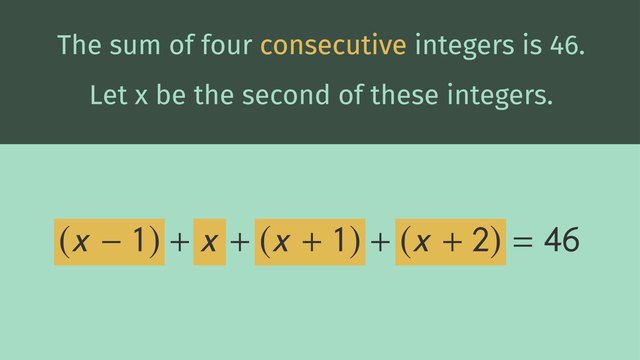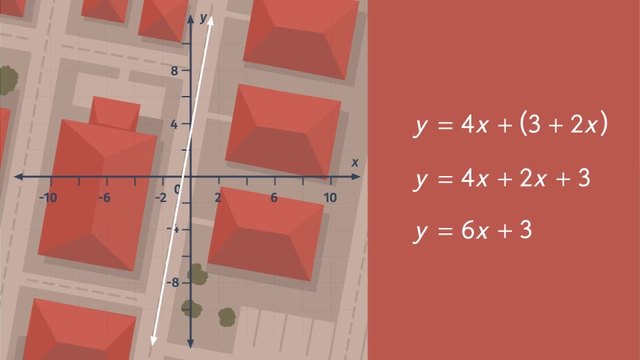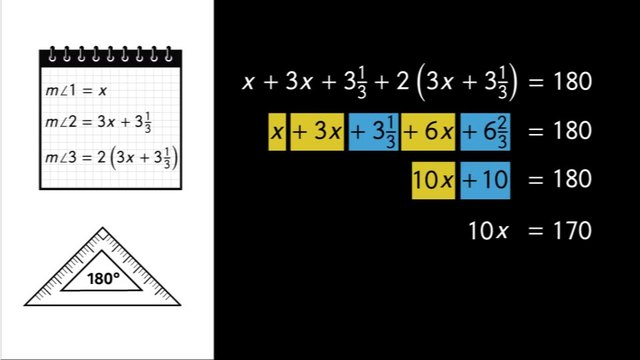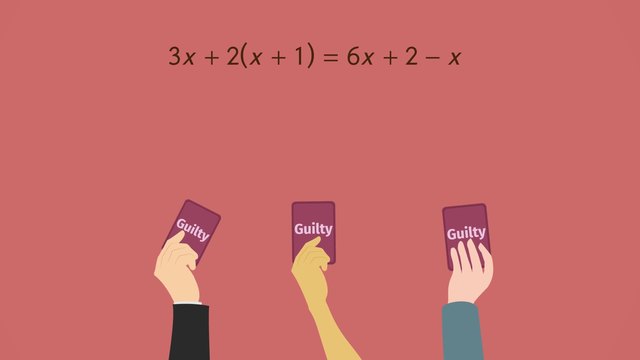Linear Equations in Disguise
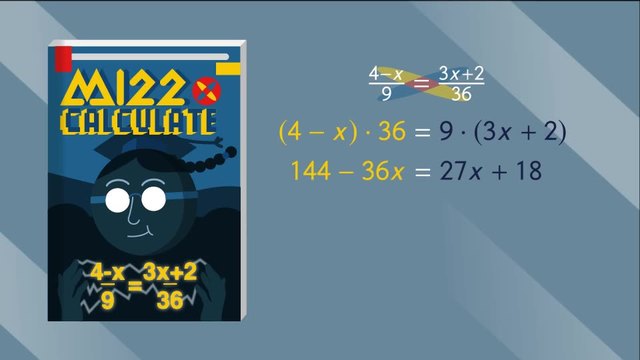

Basics on the topic Linear Equations in Disguise
A linear equation in one variable is an equation containing a single variable of degree one. To check if an equation in one variable is linear, simplify the equation, isolate the variable, and check if the variable is raised to the first power. Learn how to determine if a given equation is linear by helping Clarissa, a comics collector, figure out whether the equations written on the covers of two special editions of Miss Calculate comics which are on display are linear equations or not. Common Core Reference: CCSS.MATH.CONTENT.8.EE.C.7
Transcript Linear Equations in Disguise
Clarissa loves to collect comics. She's always obsessed with finding the next hidden gem. One day while scouring the shelves, Clarissa totally flips out! Two special editions of “Miss Calculate" the adorably nerdy hero who helps people see the error of their ways! She goes up to the store owner, who tells her these editions are VERY valuable. Normally, Miss Calculate comics are labeled with linear equations. But these are labeled with NON-linear equations. Clarissa is skeptical, so she wants to check that they really are non-linear and not just linear equations in disguise! The label on the first comic is 'x' over 7 equals 14 over 98. This looks more like a proportion than a linear equation. But there IS a variable raised to the first power and the variables in linear equations are ALWAYS raised to the first power. Let’s rewrite this proportion by cross-multiplying. Take the numerator on the left side of the equation and multiply it by the denomintor on the right side. And take the denomintor on the left side of the equation and multiply it by the numerator on the right side. Now we have 98x equals 7 times 14 or 98x equals 98. We can simplify that even further by dividing both sides by 98.
Hold on: this special edition isn’t special at all! It's just the linear equation 'x' equals one! The comic store owner swears there must be some kind of mistake, but let's check out the second equation anyway. The quantity 'four minus x' over 9 equals the quantity 'three x plus two' over 36. This one looks more complicated, but the variables are all raised to the power of one so is it a linear equation or not? Let's simplify to check. Again we use cross multiplication. Take the numerator on the left side of the equation and multiply it by the denomintor on the right side. And take the denomintor on the left side of the equation and multiply it by the numerator on the right side then apply the distributive property to get 144 minus 36x equals 27x plus 18. Next, use opposite operations to isolate the variable. Start by subtracting 144 from both sides.
Then subtract 27x to both sides and finally divide both sides by negative 63 to get x' equals two? Are you kidding me? The second book is also labeled with an ordinary linear equation! So, to review: if you want to check if an equation is linear... First, simplify the equation. Then, isolate a variable. Finally, check to see if the variable or variables are all raised to the first power. Using this strategy, Clarissa knows that this comic book guy is definitely trying to rip her off! Looks like a job for Miss Calculate, defender of computational justice! Evildoers and renegade mathematicians, beware!
Linear Equations in Disguise exercise
-
Identify the steps for solving the linear equation in disguise.
HintsBelow is an example of solving a linear equation in disguise, with the steps provided.
$ \begin{array}{c|l} \text{solution} & \text{step}\\ \hline \\ \frac{x}{6}=\frac{3}{5} & \text{original equation}\\ \\ 5x=18 & \text{cross-multiplication}\\ \\ x=\frac{18}{5} & \text{division}\\ \\ x=2\frac35 & \text{conversion to mixed number} \end{array} $
Below is an example of solving a linear equation in disguise, with the steps provided.
$ \begin{array}{c|l} \text{solution} & \text{step}\\ \hline \\ \frac{x-7}{6}=\frac{3x+1}{5} & \text{original equation}\\ \\ 5(x-7)=6(3x+1) & \text{cross-multiplication}\\ \\ 5x-35=18x+6 & \text{distribution}\\ \\ -13x=41 & \text{combine like terms}\\ \\ x=-\frac{41}{13} & \text{division}\\ \\ x=-3\frac{2}{13} & \text{conversion to mixed number} \end{array} $
Solution$ \begin{array}{c|l} \text{solution} & \text{step}\\ \hline \\ \frac{x+2}{3}=\frac{x-5}{9} & \text{original equation}\\ \\ 9(x+2)=3(x-5) & \text{cross-multiply}\\ \\ 9x+18=3x-15 & \text{distribution}\\ \\ 6x=-33 & \text{combine like terms}\\ \\ x=-\frac{33}{6} & \text{division}\\ \\ x=-\frac{11}{2} & \text{reduce the fraction}\\ \\ x=-5\frac12 & \text{convert to mixed number}\\ \end{array} $
-
Solve the linear equations in disguise.
HintsHere's an example of solving a linear equation in disguise.$ \begin{array}{c|l} \text{solution} & \text{step}\\ \hline \\ \frac{x}{20}=\frac{1-x}{10}\\ \\ 10x=20(1-x) & \text{cross-multiply}\\ \\ 10x=20-20x & \text{distribution}\\ \\ 30x=20 & \text{combine like terms}\\ \\ x=\frac{20}{30} & \text{division}\\ \\ x=\frac{2}{3} & \text{reduce the fraction}\\ \end{array} $
SolutionFirst Problem
$\begin{array}{c|l} \text{solution} & \text{step}\\ \hline \\ \frac{x}{7}=\frac23\\ \\ 3x=14 & \text{cross-multiply}\\ \\ x=\frac{14}{3} & \text{division}\\ \\ x=4\frac{2}{3} & \text{convert to mixed number}\\ \end{array}$
Second Problem
$ \begin{array}{c|l} \text{solution} & \text{step}\\ \hline \\ -\frac67=\frac{x}{14}\\ \\ -84=7x & \text{cross-multiply}\\ \\ x=-12 & \text{division}\\ \end{array} $
Third Problem
$\begin{array}{c|l} \text{solution} & \text{step}\\ \hline \\ \frac19=\frac{x-1}{3}\\ \\ 3=9(x-1) & \text{cross-multiply}\\ \\ 3=9x-9 & \text{distribution}\\ \\ 9x=12 & \text{combine like terms}\\ \\ x=\frac{12}{9} & \text{division}\\ \\ x=\frac43 & \text{reduce fraction}\\ \\ x=1\frac13 & \text{convert to mixed number}\\ \end{array}$
Fourth Problem
$\begin{array}{c|l} \text{solution} & \text{step}\\ \hline \\ \frac{x}{4}=\frac{3+x}{8}\\ \\ 8x=4(3+x) & \text{cross-multiply}\\ \\ 8x=12+4x & \text{distribution}\\ \\ 4x=12 & \text{combine like terms}\\ \\ x=3 & \text{division}\\ \end{array}$
-
Distinguish the linear equations from non-linear equations.
HintsHere are a few clues that we may be dealing with a linear equation in disguise:
- The variable is raised to the first power.
- There are no variables raised to powers other than $1$.
- There are no variables in denominators.
- There are no variables that are rooted.
- The equation is a proportion.
- There is a single solution to the equation.
Solution$ \begin{array}{c|c} \text{Linear equations} & \text{Non-linear Equations}\\ \hline \\ 2x+4=5 & 2x^3+5x-8=1\\ \\ 3x^1=7 & x^2=2\\\ \\ \frac{x}{2}=\frac{5}{7} & \sqrt{x+9}=12\\ \\ \frac{x-4}{5}=\frac{x}{6} & \frac{x^2}{3}=\frac56\\ \\ x=100 &\\ \\ x+2x+3x=4x+5x+6x +3 &\\ \end{array} $
-
Identify the linear equation which represents the given scenario.
HintsA proportion is an equation relating two ratios:
$\frac{x}{4}=\frac23$
When we say "the quantity", whatever follows should be put in parentheses. For example, two times the quantity, $x$, plus six is:
$2(x+6)$
SolutionThe ratio of Jim's height to his shadow is $\frac{5}{6}$. The ratio of the height of a flagpole to its shadow is $\frac{x}{21}$. These ratios are equal:
$\frac56=\frac{x}{21}$
The unknown height of a tree, $x$, is $21$ feet more than $5$ times my height of $6$ feet:
$x=21+5(6)$
Five times the quantity, $21$, plus $x$ is $6$:
$5(21+x)=6$
Five and $x$ are added, then the result is divided by $6$. Twenty-one and $x$ are added, then the result is divided by $5$. These two quantities are equal:
$\frac{5+x}{6}=\frac{21+x}{5}$
-
Review the steps for solving linear equations in disguise.
HintsHere is an example of solving a linear equation in disguise, with the steps indicated:
$ \begin{array}{c|l} \frac{x+1}{3}=\frac{5-x}{4} & \\ \\ 4(x+1)=3(5-x) & \text{cross-multiplication}\\ \\ 4x+4=15-3x & \text{distribution}\\ \\ 7x=11 & \text{combining like terms}\\ \\ x=\frac{11}{7} & \text{division}\\ \\ x=1\frac47 & \text{converting to mixed number} \end{array} $
Solution$ \begin{array}{c|l} \frac{2x+5}{4}=\frac{3-x}{2} & \\ \\ 2(2x+5)=4(3-x) & \text{cross-multiplication}\\ \\ 4x+10=12-4x & \text{distribution}\\ \\ 8x=2 & \text{combining like terms}\\ \\ x=\frac28 & \text{division}\\ \\ x=\frac14 & \text{reducing fraction} \end{array} $
-
Determine which equations are linear.
HintsLinear equations can have variables with fractional coefficients. This is a linear equation:
$\frac78 x + \frac19 =-\frac23 x$
In linear equations, the variables are only raised to the power of $1$.
This is a linear equation:
$3x=4x^1+5$
The constants in linear equations can feature powers other than one and the equation will still be linear. These are linear equations:
$x+5^2=9$
$x=\sqrt{7}$
If the variable is raised to a power other than one, or rooted, we don't have a linear equation. These are non-linear equations:
$4x^3+7=9$
$3\sqrt{x}=5$
If there is a variable in the denominator, we may not have a linear equation. This is not a linear equation:
$\frac{x}{4}=\frac{5}{x}$
Solution$x=4^2$ This equation is the same as $x=16$. That means it is linear.
$x^2=4$ This equation features a variable squared. That means it is non-linear.
$5x^1+\frac67=\sqrt{9}$ This equation features a variable to the first power. We can root or square any constants and the equation will still be linear.
$5\sqrt{x}=10$ This equation features the root of a variable. This equation is non-linear.
$\frac{x+4}{7}=\frac{3x-5}{2}$ This equation is linear.
$\frac{7}{x+4}=\frac{3x+5}{2}$ This equation features a variable in the denominator of a fraction, and it's non-linear.
$\frac13 x +\frac45 =\frac12 x^2$ This equation features a variable squared, so it's non-linear.
$\frac13 x +\frac45 =\frac12 x$ This equation is linear.


